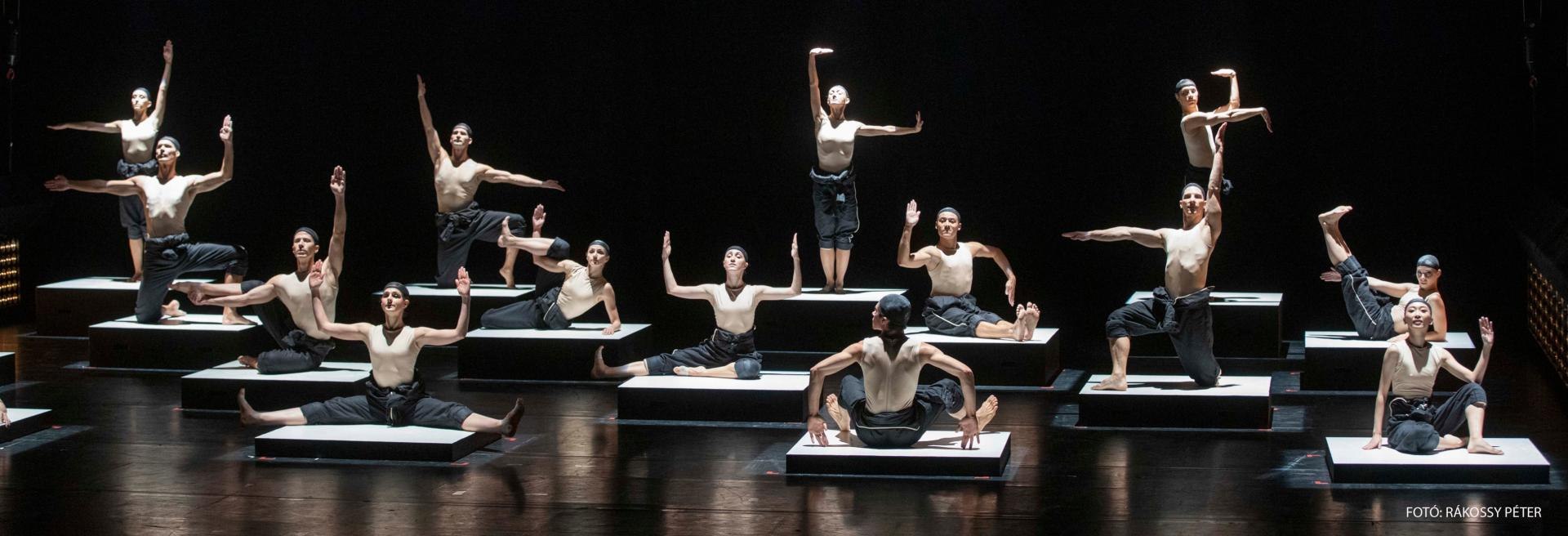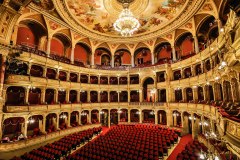Bittersweet Comedies
October 2025 | ||||||
|---|---|---|---|---|---|---|
Mo | Tu | We | Th | Fr | Sa | Su |
Modern ballet
Bittersweet Comedies – Johan Inger - Alexander Ekman - Sol Leon & Paul Lightfoot
Walking Mad, Cacti, Sad Case
Running time: 2 hours including one intermission
Walking Mad | Johan Inger / Maurice Ravel – Arvo Pärt
A wall, 3 female and 6 male
dancers, and Ravel's Bolero. This is the base of Swedish choreographer Johan Inger's one-act ballet, which he originally created for the Netherlands Dans Theatre in 2001.
The minimalist space takes newer and newer shapes for the ever intensifying music, and newer and newer characters appear in it, in more and more mad situations and states.
"The famous Bolero from Ravel with its sexual, almost kitschy history was the trigger point to make my own version. I quickly decided that it was going to be about relationships in different forms and circumstances. I came up with the idea of a wall that could transform the space during this minimalistic music and create small pockets of space and situations. Walking Mad is a journey in which we encounter our fears, our longings and the lightness of being.
»Our biggest blessings come to us by way of madness« - said Socrates."Johan Inger
Cacti | Alexander Ekman / Franz Joseph Haydn – Ludwig van Beethoven – Franz Schubert
Choreographer Alexander Ekman addresses on the contemporary dance stage a theme with which he defines himself as well: modern dance itself. The work passionately, and often raucously, picks apart the mannerisms of dance. Sixteen dancers stand visibly frozen on gigantic Scrabble tiles. While the string quartet plays and ironic-sounding words are heard spoken, the dancers run around, fall down, writhe on the floor and attempt to escape from their invisible prison. Eventually, each of them acquires a cactus. A play of rhythms between dancers and musicians.
Sad Case | Sol León & Paul Lightfoot / P. Prado – A. Dominguez – E. Lecuona – R. Barretto – Trio Los Pancho
“Now in hindsight we realise that energy is everything. When we created Sad Case in 1998, so far in to Sol’s pregnancy, the hormones were jumping and emotions were high. It is these hormones of laughter, madness and the trepidation of the unknown ahead that are the umbilical chord of this work,” says the British Paul Lightfoot, thinking back to the origin of the ballet. He and his partner, the Spanish Sol León share credit for the performance’s choreography and set and costume designs. Up until 2020, León worked as artistic consultant and Lightfoot as artistic director for the Nederlands Dans Theater (NDT), where they were responsible for bringing about sixty creations, including Sad Case, which is undoubtedly one of the pillars of their work. In it, surprising movements set to Mexican mambo music reflect the ongoing search for the tension between the satirical and the serious. The Opera has long planned the staging of this irresistible modern piece for Hungarian audiences – and by way of it, the art of the world-famous Lightfoot.
Program and cast
Walking Mad
Girls - Soobin Lee, Lea Földi, Jessica Leon Carulla, Anna Krupp, Rita Hangya, Claudia García Carriera
Boys - András Rónai, Iurii Kekalo, Gaetano Cottonaro, Kristóf Morvai, Ricardo Vila M., Mahillo Carlos Taravillo, Louis Scrivener, Boris Zhurilov, Dmitry Timofeev, Dmitry Zhukov, Kamill Kökény-Hámori, Dávid Molnár
Choreographer: Johan Inger
Lighting designer: Peter Lundin
Lighting designer: Erik Berglund
Ballet master: Carl Inger
Ballet master: Yvan Dubreuil
Cacti
Solo girl - Aglaja Sawatzki, Adrienn Pap
Solo boy - Francesco Sardella, Yago Guerra
Boy (impro) - Kamill Kökény-Hámori, Alberto Ortega de Pablos
Choreographer: Alexander Ekman
Set and costume designer: Alexander Ekman
Lighting designer: Tom Visser
Ballet master: Ana Lucaciu, Nina Botkay
Hungarian translation by Minka Benkő
Sad Case
Girls - Maria Beck, Miyu Takamori, Kristina Starostina, Yuki Wakabayashi
Boys - Gergő Ármin Balázsi, Mahillo Carlos Taravillo, Vince Topolánszky, Valerio Palumbo, Francesco Sardella, Motomi Kiyota
Choreographer: Sol León, Paul Lightfoot
Set and costume designer: Sol León, Paul Lightfoot
Lighting designer: Tom Breevort
Ballet master: Lou Menghan
Hungarian State Opera
STANDING ROOM TICKETS - INFORMATION IN CASE OF A FULL HOUSE!
If all the seats are sold out for the selected time, but you still want to see the production on that day, 84 of the extremely affordable standing seats will be sold at the theatre, 2 hours before the start of the performance, with which you can visit the gallery on the 3rd floor. Tickets can be purchased at the ticket office of the Budapest Opera House. We would like to draw your attention to the fact that the stage can only be seen to a limited extent from the standing places and the side seats, but at the same time, following the performance is also supported by television broadcasting on the spot.
The Opera House is not only one of the most significant art relic of Budapest, but the symbol of the Hungarian operatic tradition of more than three hundred years as well. The long-awaited moment in Hungarian opera life arrived on September 27, 1884, when, in the presence of Franz Joseph I. the Opera House was opened amid great pomp and ceremony. The event, however, erupted into a small scandal - the curious crowd broke into the entrance hall and overran the security guards in order to catch a glimpse of the splendid Palace on Sugar út. Designed by Mikós Ybl, a major figure of 19th century Hungarian architecture, the construction lived up to the highest expectations. Ornamentation included paintings and sculptures by leading figures of Hungarian art of the time: Károly Lotz, Bertalan Székely, Mór Than and Alajos Stróbl. The great bronze chandelier from Mainz and the stage machinery moda by the Asphaleia company of Vienna were both considered as cutting-edge technology at that time.
Many important artists were guests here including Gustav Mahler, the composer who was director in Budapest from 1887 to 1891. He founded the international prestige of the institution, performing Wagner operas as well as Magcagni’ Cavalleria Rusticana. The Hungarian State Opera has always maintained high professional standards, inviting international stars like Renée Fleming, Cecilia Bartoli, Monserrat Caballé, Placido Domingo, Luciano Pavarotti, José Cura, Thomas Hampson and Juan Diego Flórez to perform on its stage. The Hungarian cast include outstanding and renowed artists like Éva Marton, Ilona Tokody, Andrea Rost, Dénes Gulyás, Attila Fekete and Gábor Bretz.

 EN
EN DE
DE IT
IT FR
FR ES
ES RU
RU JP
JP RO
RO
 Seating plan
Seating plan 